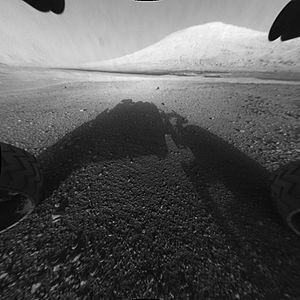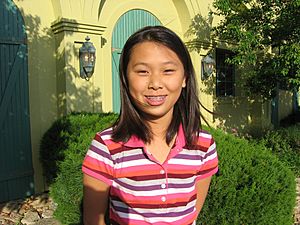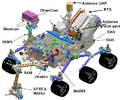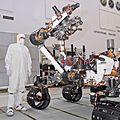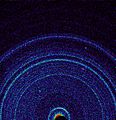Curiosity rover facts for kids
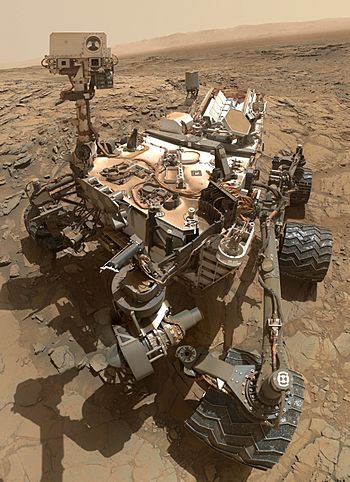
Self-portrait of Curiosity located at the foothill of Mount Sharp (October 6, 2015)
|
|
| Mission type | Mars rover |
|---|---|
| Operator | NASA |
| Mission duration | Primary: 668 sols (687 days) Current: 4751 sols (4881 days) since landing |
| Spacecraft properties | |
| Manufacturer | |
| Dry mass | Rover only: 899 kg (1,982 lb) |
| Start of mission | |
| Launch date | November 26, 2011, 15:02:00 UTC |
| Rocket | Atlas V 541 (AV-028) |
| Launch site | Cape Canaveral LC-41 |
| Orbital parameters | |
| Reference system | Heliocentric (transfer) |
| Mars rover | |
| Spacecraft component | Rover |
| Landing date | August 6, 2012, 05:17:57 UTC SCET MSD 49269 05:53:28 AMT |
| Landing site | Aeolis Palus ("Bradbury Landing") in Gale Crater (4°35′22″S 137°26′30″E / 4.5895°S 137.4417°E) |
| Distance covered | 18.13 km (11.27 mi) as of 11 February 2018[update] |
|
Mars rovers (NASA)
|
|
The Curiosity rover is a robotic, car-sized vehicle exploring the planet Mars. It is currently exploring Gale Crater, which is a large impact crater near the Martian equator. Curiosity is powered by a special nuclear battery and is a key part of NASA's Mars Science Laboratory (MSL) mission.
The main goals of the MSL mission are to study Mars's climate and geology. Scientists also want to search for signs of water and find out if Mars could have ever supported tiny living things. Curiosity carries the most advanced scientific tools ever sent to the surface of Mars.
Curiosity is the fourth NASA rover to land on Mars in 16 years. It is also the heaviest robotic vehicle to land on Mars, weighing about 900 kilograms (1,982 pounds). It launched from Cape Canaveral on November 26, 2011. The rover successfully landed in Aeolis Palus within Gale Crater on Mars on August 6, 2012.
In December 2012, Curiosity's original two-year mission was extended indefinitely. This means it will keep exploring as long as it can. On August 7, 2017, NASA celebrated five years since Curiosity landed. The rover is still working today, continuing its amazing discoveries on Mars.
The design of Curiosity was used as a model for the Mars 2020 rover, which was launched in July 2020.
Contents
What are Curiosity's Goals?
The main scientific goal of the MSL mission is to find out if Mars could have ever supported life or had water. The mission also aims to study the climate and geology of Mars. The Curiosity rover has six main scientific objectives:
- Look for different minerals and rocks on the crater surface.
- Search for signs that life might have existed on Mars.
- Understand how rocks and soil on Mars were formed and changed over time.
- Study the atmosphere of Mars, which is the air surrounding the planet.
- Watch how water and carbon dioxide move around on Mars.
- Investigate the radiation on the surface, including cosmic radiation from space.
Where Did Curiosity Land?
Curiosity was planned to land in a small area called Aeolis Palus inside Gale Crater. Gale Crater is a very old impact crater on Mars, formed about 2 billion years ago. It was once filled with sediments by water and wind. Over time, wind blew away most of these sediments, leaving behind a 5.5-kilometer (3.4-mile) high mountain called Mount Sharp.
The crater is 154 kilometers (94 miles) wide. Scientists chose this crater because it might hold clues about 2 billion years of Martian history. The landing site is also near an alluvial fan, which is a fan-shaped deposit of sediment. Scientists believe this fan was created by flowing groundwater.
How Was Curiosity Named?
NASA chose the name Curiosity after a contest for students across the United States. More than 9,000 ideas were sent in! The winning name came from Clara Ma, a twelve-year-old sixth-grade student from Sunflower Elementary School in Lenexa, Kansas.
As her prize, Clara got to visit NASA's Jet Propulsion Laboratory (JPL) in Pasadena, California. There, she signed her name directly onto the rover while it was being put together.
In her winning essay, Clara wrote:
Curiosity is an everlasting flame that burns in everyone's mind. It makes me get out of bed in the morning and wonder what surprises life will throw at me that day. Curiosity is such a powerful force. Without it, we wouldn't be who we are today. Curiosity is the passion that drives us through our everyday lives. We have become explorers and scientists with our need to ask questions and to wonder.
From 2009 to 2011, NASA also gave the public a chance to send their names to Mars. Over 1.2 million people from all over the world participated! Their names were carved onto a tiny silicon chip using a special machine at JPL. This chip is now attached to the deck of Curiosity.
A plaque with the signatures of President Barack Obama and Vice President Joe Biden was also placed on the rover. This follows a 40-year tradition for space missions.
On August 6, 2013, Curiosity did something special: it played "Happy Birthday to You" to celebrate one Earth year since its landing on Mars. This was the first time a song was played on another planet! It was also the first time music was sent between two planets.
Studying Mars's Geology
The Curiosity rover has three scoops that can dig up soil samples on Mars. These samples are then studied inside the rover. The scoops are kept clean by using Martian sand to scrub them.
Inside Curiosity, there's a special tool called CheMin (Chemistry and Mineralogy instrument). CheMin uses X-rays to figure out what minerals are in the soil samples. This important information is then sent back to Earth for scientists to study.
Images for kids
-
Curiosity and surrounding area as viewed by MRO/HiRISE. (14 August 2012)
-
First X-ray diffraction view of Martian soil by Curiosity (October 17, 2012).
See also
 In Spanish: Curiosity para niños
In Spanish: Curiosity para niños


